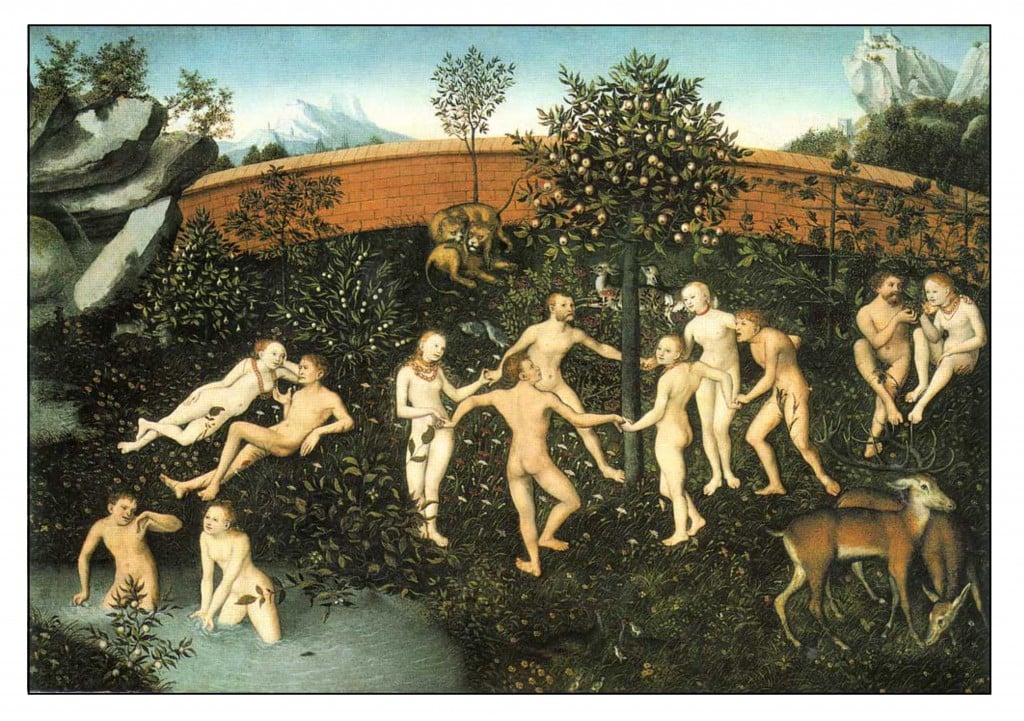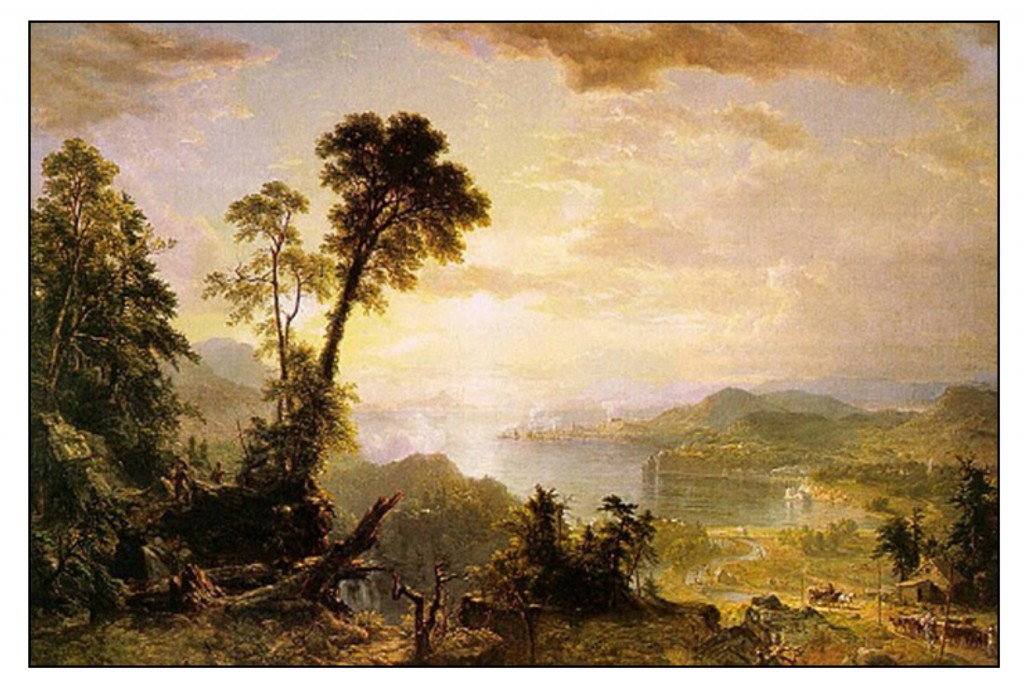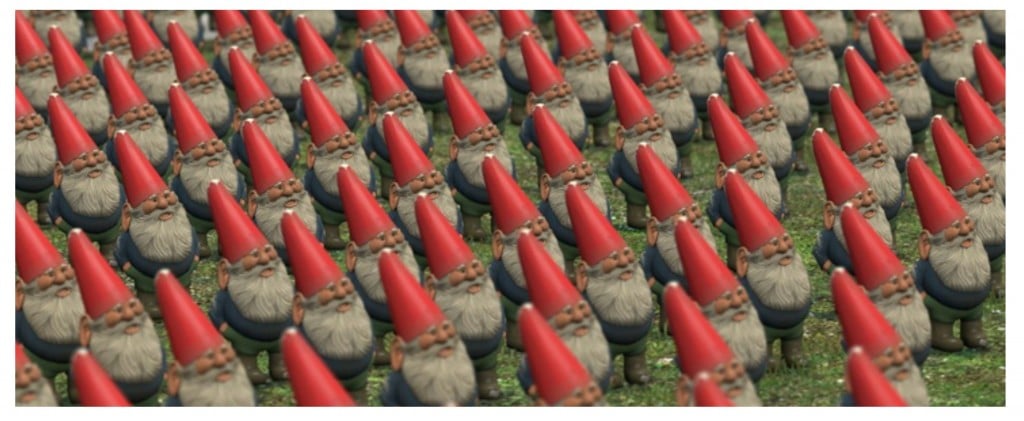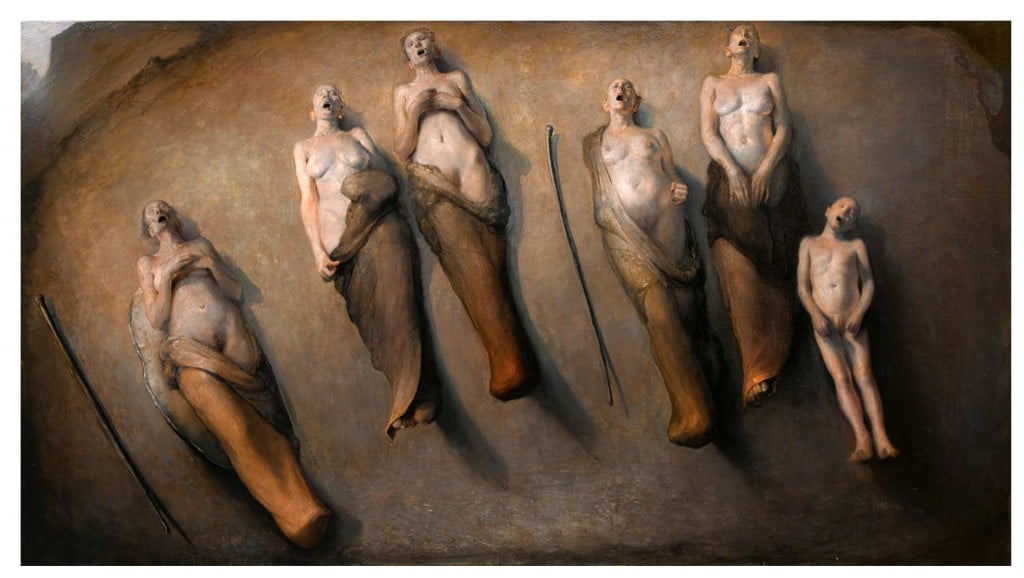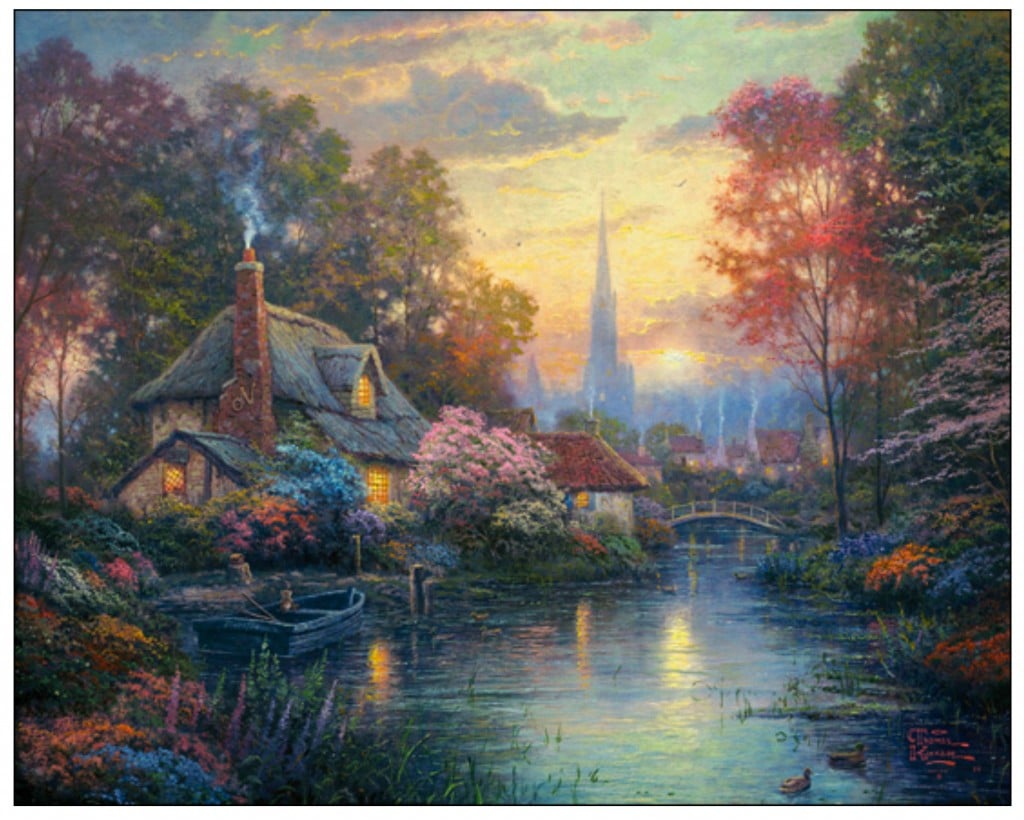Progress
Loss of Paradise
The ancients did not believe in progress (Bury, 1932; Pollard, 1968; Meek Lange, 2011). They had two main ideas of how the world changes over time. One was that an initial state of peace and plenty – the Garden of Eden of Genesis, the Golden Age of Hesiod, or the Arcadia of Virgil – had degenerated over time to our present world of strife and suffering.
The decline from our golden beginnings to the present age of iron might have been simply caused by the passage of time, but more often than not it was attributed to human foolishness. The Jews told the story of original sin and the Greeks recounted the myth of Pandora’s box.
Lucas Cranach (1530) portrayed the Golden Age as a time when we could dance without fear of the lion and eat of the tree of knowledge without concern for the consequences. The word “paradise” means an area enclosed by a wall. Suffering and death remained outside the wall.
Our forefathers’ second concept was that nothing ever really changes. The world may go through cycles of improvement and deterioration, but in the end everything stays about the same. The world is not perfect and never will be. The Jewish preacher Ecclesiastes (3rd Century BCE, 1:9, KJV) claimed that all is vanity:
The thing that hath been, it is that which shall be; and that which is done is that which shall be done: and there is no new thing under the sun.
The Roman Emperor Marcus Aurelius (180 CE, Meditations X:I, Staniforth translation) proposed that the soul
… can encompass the whole universe at will, both its own structure and the void surrounding it, and can reach out into eternity, embracing and comprehending the great cyclic renewals of creation, and thereby perceiving that future generations will have nothing new to witness, even as our forefathers beheld nothing more than we of today.
These two ideas of history were often combined. Our original paradise cannot be regained. The beings that began in Eden now find themselves condemned forever to brief lives characterized more by suffering than by happiness, and leading inexorably to death.
Eastern religions adopted a similar view. They conceived of human life as a continual reincarnation into a world of suffering. The only escape was from the ongoing cycle of death and rebirth (samsara) was to remove oneself from the changing world (maya) by abdicating all desire and dedicating oneself to wisdom and charity.
City of God
Into the gloom that pervaded much of our ancient wisdom came the idea of salvation. Belief in the resurrection of Jesus Christ would allow the believer to escape to Heaven at the end of life. Failure to believe, however, would lead to Hell. In the 5th Century CE, Saint Augustine proposed that human beings can choose either to belong to the City of God or to remain in the Earthly City, the one founded by Cain (City of God, XV:1). People of the City of God progress “from earthly to heavenly things, and from the invisible to the invisible” (X:14).
The illustration at the right shows a terra cotta maquette from the Hermitage, a model for Bernini’s 1650 statue of Augustine in St Peter’s Cathedral. Bernini’s sculpture was meant to seen from many different perspectives. So perhaps we are not amiss in interpreting Augustine’s work in ways not intended by the saint.
The idea of Christian salvation, like the benefits of many other religions, is basically mean-spirited and divisive. An elect will go to heaven; all others will not. Membership in the elite is not awarded on the basis of achievement but gifted by the grace of God. Indeed, Augustine believed that since God is omniscient, membership in the elect is pre-ordained.
Great Chain of Being
Augustine’s thinking was embedded in the notion of a Great Chain of Being (Lovejoy, 1936) that he derived from Greek philosophers, most notably from the Neoplatonist Plotinus. God created the world. Within this world everything was arranged hierarchically from inanimate matter at the bottom through plants, animals, man, and angels, to God at the top. This concept was extensively worked out in medieval Scholasticism, but persisted long after, as evidenced by Alexander Pope’s lines in his Essay on Man (1734, Epistle I:VIII):
Vast chain of being, which from God began,
Natures ethereal, human, angel, man,
Beast, bird, fish, insect! what no eye can see,
No glass can reach! from infinite to thee,
From thee to nothing!
The hierarchy also characterized human society with the anointed King placed at the top, the lords and clergy below and the peasants at the very bottom. Society was not supposed to change: one knew one’s place, and did not move between the levels.
Enlightenment
All this began to change with the emergence in the Europe of the 16th and 17th centuries of a new way of thinking that questioned the authority of the past. The very idea that we may not have understood the world correctly in the past implied that we might understand it better in the future.
This way of thinking led to the Enlightenment of the 18th Century. The new sciences had shown that we could understand more and more about the workings of the world, derive laws to predict what might happen, and harness energy to change the world which controlled us. Lives were becoming better.
The Enlightenment gave birth to our modern idea of progress. In 1750 Anne-Robert-Jacques Turgot, Baron de l’Aulne (1727-1781) published an essay entitled A Philosophical Review of the Successive Advances of the Human Mind. He agreed with the ancients that
All things perish, and all things spring up again; and in these successive acts of generation through which plants and animals reproduce themselves time does no more than restore continually the counterpart of what it has caused to disappear.
This sounds much like Marcus Aurelius. However, Turgot also noted that human beings were different from the rest of the world, since they can accumulate and communicate knowledge:
The succession of mankind, on the other hand, affords from age to age an ever-changing spectacle. Reason, the passions, and liberty ceaselessly give rise to new events …. The arbitrary signs of speech and writing, by providing men with the means of securing the possession of their ideas and communicating them to others, have made of all the individual stores of knowledge a common treasure-house which one generation transmits to another, an inheritance which is always being enlarged by the discoveries of each age.
This allows the idea of progress, whereby
… the whole human race, through alternate periods of rest and unrest, of weal and woe, goes on advancing, although at a slow pace, towards greater perfection (all quotations from Turgot, 1750, p. 41).
Turgot became most famous for his work on economics, his Reflections on the Formation and Distribution of Wealth being one of the foundational works of economic liberalism. Nevertheless, it is to him in particular and to the Enlightenment in general that we must trace the origin of our idea of progress (Younkins, 2006; Meek Lange, 2011). The statue of Turgot by Pierre Travaux (1853) illustrated above was appropriately photographed in the bright sunlight. Turgot was one of the giants of the Enlightenment.
Science advanced rapidly the 18th and 19th Centuries and by the beginning of the 20th Century it appeared that everything was within our reach. The study of thermodynamics had led to steam engines and automobiles, the study of electricity had given us artificial lighting and telephones, and the study of medicine had resulted in anesthetics and vaccines.
Society had become more humane. To some extent a belief in progress replaced our earlier belief in salvation.
Humanism is not science, but religion – the post-Christian faith that humans can make a world better than any in which they have so far lived … Christians understood history as a story of sin and redemption. Humanism is the transformation of this Christian doctrine of salvation into a project of universal human emancipation. The idea of progress is a secular version of the Christin belief in providence. (Gray, 2003. xiii)
No one was more enthusiastic in their belief in Progress than the people of the United States. They considered it their manifest destiny to replace the simple life of the Native Americans with the railways and industry of European civilization. The 1853 painting of Progress by Asher Brown Durand of the Hudson Valley School portrayed the changing American landscape. On the left are the Native Americans and on the right the New Americans. The unspoiled wilderness gives way to the glorious future. Both are suffused in sunshine: nostalgia for paradise is balanced by hope of heaven.
March of Progress
The Theory of Evolution inverted the Great Chain of Being. God did not create the world and all that is within it. Rather, the world evolved from inanimate to animate and from simple to complex. Man descended from earlier humanoid species, that themselves had descended from monkeys. The universe developed from bottom up rather than from top down.
Religion generally rejected this world view. However some religious philosophers tried to combine evolution with divine purpose. Man was perhaps evolving toward a perfect being, an Omega Point where everything would be understood, time would cease, and God and man become one. (Teilhard de Chardin, 1959).
The evolution of man was often portrayed as a March of Progress. The most famous of these illustrations was by Rudolph Zaillinger for the Time-Life book on Early Man (Howell, 1965):
The idea of the March of Progress was conceived in much the same way as the Great Chain of Being, although the sequence was temporal rather than heirarchic. Yet it remained a chain, and we often engage in a futile search for missing links.
Zaillinger’s picture suggests a linear sequence, with each humanoid species evolving into the next. This is completely wrong. Evolution has multiple branches, with most of the branches ending with extinction. Evolutionary progress is better illustrated by a bush than by a ladder (Gould, 1989). Furthermore, the evolution of man appears to have depended much more on chance contingencies than on an inevitable path. This does not make progress directionless, but does underline its precariousness.
Brave New World
As the Enlightenment progressed, the Common Man began refused to stay subservient. The Divine Right of Kings no longer held; revolutions occurred; democracy began to flourish. In the 20th Century governments began to grant Universal Suffrage.
However, we may have become too confident. Butterfield (1931) pointed out the human tendency to conceive of past history as necessarily progressing to the perfection of the present. Our present happiness simply confirms that our past policies were correct. The Great War shook this simple faith. Where could one place such terrible carnage in any concept of progress?
The tendency to see the present as the best of all possible worlds persists. After the fall of the Berlin Wall, Francis Fukuyama announced the End of History (1989). Fascism had been defeated; communism had failed; democracy had triumphed:
What we may be witnessing is not just the end of the Cold War, or the passing of a particular period of post-war history, but the end of history as such: that is, the end point of mankind’s ideological evolution and the universalization of Western liberal democracy as the final form of human government.
All that was then needed was to export democracy to the rest of the world. Today we live with the violent results of this idea. The world and human society are far more complex than they appear. Progress may be both desirable and possible, but it will require more foresight than we have shown so far.
Angelus Novus
Not everyone subscribed to the idea that progress is beneficial. The first half of the 20th Century undermined everyone’s faith. The rise of fascism in Europe, the war that it unleashed, the horror of the Holocaust, and the use of nuclear weapons were strong lines of evidence that history was descending into evil rather than progressing toward good.
Walter Benjamin gave terrifying poetic voice to this possibility by evoking a 1920 painting of Paul Klee:
A Klee painting named “Angelus Novus” shows an angel looking as though he is about to move away from something he is fixedly contemplating. His eyes are staring, his mouth is open, his wings are spread. This is how one pictures the angel of history. His face is turned toward the past. Where we perceive a chain of events, he sees one single catastrophe which keeps piling wreckage upon wreckage and hurls it in front of his feet. The angel would like to stay, awaken the dead, and make whole what has been smashed. But a storm is blowing from Paradise; it has caught in his wings with such violence that the angel can no longer close them. This storm irresistibly propels him into the future to which his back is turned, while the pile of debris before him grows skyward. This storm is what we call progress. (Benjamin 1941, 257–8)
Benjamin’s warnings were disregarded in the years of peace and prosperity that followed World War II. In recent years, however, the idea that progress can be evil has been reconsidered:
To believe in progress is to believe that, by using the new powers given us by growing scientific knowledge, humans can free themselves from the limits that frame the lives of other animals. This is the hope of nearly everybody nowadays, but it is groundless. For though human knowledge will very likely continue to grow and with it human power, the human animal will stay the same: a highly inventive species that is also one of the most predatory and destructive. (Gray, 2003, p. 4)
If anything about the present century is certain, it is that the power conferred on ‘humanity’ by new technologies will be used to commit atrocious crimes against it. (Gray, 2003, p. 14)
It is not hard to find historical examples of progress leading to problems (Wright, 2006). For example, the invention of flint arrows facilitated hunting but may have also led to the extinction of the very game that early man was pursuing. In addition, arrows provided yet another way for human beings to murder each other. Wright considers this early weaponry an example of a “progress trap” something that initially improves our lives but ultimately makes them worse.
Many of the problems brought on by progress are linked to human failings, particularly to selfishness. Wright considers the discovery of agriculture in this light:
The invention of agriculture is itself a runaway train, leading to vastly expanded populations but seldom solving the food problem because of two inevitable (or nearly inevitable) consequences. The first is biological: the population grows until it hits the bounds of the food supply. The second is social: all civilizations become hierarchical; the upward concentration of wealth ensure that there will never be enough to go around. (Wright, 2006, p. 108).
Modern democracies base their economies on capitalism. As well as being inherently unfair, capitalism cannot survive without continually increasing consumption. This has led to our current ills of pollution and climate-change:
Capitalism lures us on like the mechanical hare before the greyhounds, insisting that the economy is infinite and sharing therefore irrelevant. Just enough greyhounds catch a real hare now and then to keep the others running till they drop. In the past it was only the poor who lost this game; now it is the planet. (Wright, 2006, p. 124).
Nevertheless
Though we must properly consider the problems that we face, we must not lose sight of the fact that we are getting better even if the pace is slow and variable. Despite the tremendous loss of life in the two world wars of the 20th Century, we are less murderous now than in the past (Pinker, 2011, 2015). Though governments are far from perfect, the people of the present world have more rights now than in the days of kings. And even if science can lead to such terrible things as nuclear war, it has also provided us with the benefits of modern agriculture, transportation, communication and medicine.
We are right to be careful. Yet we should not do away with progress and retreat to the past. The paradise that we think we remember is not real. The future dystopias we imagine are warnings not necessary predictions.
Temple of Longing
To balance Benjamin’s vision of the angel we might conclude with another of Paul Klee’s paintings, Mural from the Temple of Longing (1922). The colors of the painting come from the desert. The surface is weathered as if by wind and sand. The shapes likely represent a mountain village in North Africa. Klee had been irrevocably changed by a brief sojourn in Tunis in the summer of 1914, and themes from that visit recur in many of his paintings. The blues of the picture suggest twilight, and the circular and semicircular shapes in the upper part of the picture may hint at a moon both full and waxing.
The various vertical constructions terminate in arrows which move away from us, upward and deeper into the space of the picture. Arrows occur many times in Klee’s paintings and mean many things: the passage of time, the movement of things, and the force of desire. Here they may represent thoughts or questions:
The father of the arrow is the thought: how do I expand my reach? Over this river? This lake? That mountain? (Klee, 1925, p. 54)
A faith in progress is necessary. We should not simply accept our present state. We should long for a better world. However, we should always question how we should change the present to the future. And we should proceed with caution.
References
Benjamin, W., (1940, translated by H. Zohn, 1969). Theses on the philosophy of history. In
Illuminations. (pp. 253–264). New York: Schocken.
Bury, J. B. (1932). The idea of progress: An inquiry into its origin and growth. New York: Macmillan. Available at Internet Archive
Butterfield, H. (1931). The Whig interpretation of history. London: G. Bell and Sons.
Fukuyama, F. (1989). The End of History? The National Interest, Summer: 3–18.
Gould, S. J. (1989). Wonderful Life: The Burgess Shale and the Nature of History, New York: W.W. Norton.
Gray, J. (2003). Straw dogs: Thoughts on humans and other animals. London: Granta.
Howell, F. C. (1965). Early Man, New York: TIME-LIFE Books, (pp. 41–45).
Klee, P. (1925, translated Moholy-Nagy, S., 1953). Pedagogical sketchbook. London: Faber. (p. 54)
Lovejoy, A. O. (1936). The great chain of being: A study of the history of an idea. Cambridge, MA: Harvard University Press.
Meek Lange, M. (2011). Progress. Stanford Encyclopedia of Philosophy.
Pinker, S. (2011). The better angels of our nature: Why violence has declined. New York: Viking.
Pinker, S. (September 11, 2015). Now for the good news: things really are getting better. The Guardian.
Pollard, S. (1968, reprinted 1971). The idea of progress: History and society. Harmondsworth, Middlesex, UK: Penguin Books.
Teilhard de Chardin, P. (translated by Wall, B., 1959). The phenomenon of man. London: Collins
Turgot, A.-R.-J., (1750, translated by Meek, R. L., 1973). A philosophical review of the successive advances of the human mind. In Turgot on progress, sociology and economics. Cambridge, UK: University Press. Much of this is available on Google Books
Wright, R. (2006). An illustrated short history of progress. Toronto: House of Anansi Press.
Younkins, E. W. (2006). Turgot on progress and political economy. Le Québécois Libre. 186. Available on webpage
